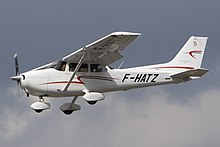| Revision as of 14:57, 7 January 2025 editMarthy49 (talk | contribs)208 editsNo edit summary← Previous edit | Revision as of 13:48, 8 January 2025 edit undoPizzaonpineapple (talk | contribs)301 edits Added tagTags: Visual edit Mobile edit Mobile web editNext edit → | ||
| Line 1: | Line 1: | ||
| ]<ref name="typecert">{{cite web|url=https://www.easa.europa.eu/en/document-library/type-certificates/aircraft-cs-25-cs-22-cs-23-cs-vla-cs-lsa/easaima051-cessna-172 |title=EASA.IM.A.051 - Cessna 172 Series (Skyhawk) |date=2 November 2021 }}</ref>]] | {{No reliable sources}}]<ref name="typecert">{{cite web|url=https://www.easa.europa.eu/en/document-library/type-certificates/aircraft-cs-25-cs-22-cs-23-cs-vla-cs-lsa/easaima051-cessna-172 |title=EASA.IM.A.051 - Cessna 172 Series (Skyhawk) |date=2 November 2021 }}</ref>]] | ||
| '''EASA CS-23''' is the ] '''C'''ertification '''S'''pecification for Normal, ], ] and Commuter Aeroplanes. | '''EASA CS-23''' is the ] '''C'''ertification '''S'''pecification for Normal, ], ] and Commuter Aeroplanes. | ||
Revision as of 13:48, 8 January 2025
| This article does not cite any reliable sources. Reliable sources are necessary to demonstrate that a particular subject is notable enough to warrant an article. Please help by identifying at least one reliable source that gives significant coverage of the topic, and adding it to this article. If at least two such sources cannot be found, the article may be considered for deletion. (Learn how and when to remove this message) |

EASA CS-23 is the European Union Aviation Safety Agency Certification Specification for Normal, Utility, Aerobatic and Commuter Aeroplanes.
This certification procedure applies to light aircrafts:
- Aeroplanes in the normal, utility, or aerobatic categories with a maximum of 9 seats (excluding pilot(s)) and a maximum take-off mass of 5,670 kg (12,500 lbs);
- Aeroplanes in the commuter category with a maximum of 19 seats (excluding pilot(s)) and a maximum take-off mass of 8,618 kg (19,000 lbs).
Depending on the chosen category, CS-23 prescribes several maneuvers (CS 23.3):
- Normal Category: Normal flight, no aerobatics; stalls as well as chandelles, lazy eights, and steep turns with a maximum bank angle of 60°;
- Utility Category: As Normal Category, but with bank angles up to 90°; additionally spins, if approved by the manufacturer;
- Aerobatic Category: No limitations imposed by the certification regulation;
- Commuter Category: Normal flight, stalls, and steep turns with bank angles up to 60°.
Aircraft not certified in the commuter category can be certified for multiple categories.
It describes the minimum requirements that must be met for the certification of an aircraft in this class. If the manufacturer of the aircraft has sufficiently demonstrated all points, the certification authority issues a type certificate.
Certification Specifications are "soft law", which is not legally binding. Manufacturers may apply for exemptions from CS-23 where necessary.
See also
- List of large aircraft
- List of current production certified light aircraft
- EASA CS-LSA, the European certification for Light Sport Aeroplanes (maximum 600 for land / 650 kg for seaplanes)
- EASA CS-VLA, the European certification for Very Light Aircraft (maximum 750 kg)
- EASA CS-25, Large Aeroplanes
- EASA CS-27, Small Rotorcraft
- EASA CS-29, Large Rotorcraft
- Federal Aviation Regulations § Part 23
- Transport category
References
- "EASA.IM.A.051 - Cessna 172 Series (Skyhawk)". 2 November 2021.
- "Regulations Structure" (PDF). EASA. 18 March 2014. Retrieved 13 March 2024.
These AMC/GM are so-called 'soft law' (non-binding rules), and put down in form of EASA Decisions. A comprehensive explanation on AMC in form of questions and answers can be found on the FAQ section of the EASA website.. Furthermore, Certification Specifications are also related to the implementing regulations, respectively their parts. Like AMC/GM they are put down as Decisions and are non-binding.
External links
- CS-23 Normal, Utility, Aerobatic and Commuter Aeroplanes | EASA
- CS-23 Amendment 6 (Mar. 2023, latest) in PDF format
- CS-23 Initial Issue (Nov. 2003) in PDF format
This aviation-related article is a stub. You can help Misplaced Pages by expanding it. |